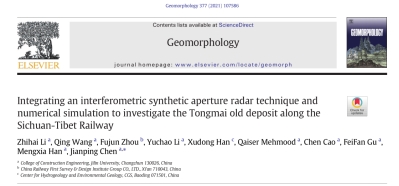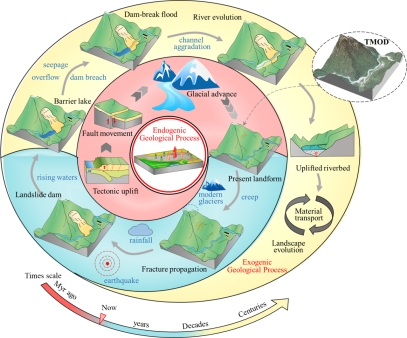In January 2021, Professor Jianping Chen's team from the college of Construction Engineering of Jilin University published a paper entitled "Integrating an interferometric synthetic aperture radar technique and numerical simulation to investigate the Tongmai old deposit along the Sichuan-Tibet Railway" in the internationally renowned academic journal "Geomorphology". The paper presents the results of the research on the genesis and deformation evolution sequence of the Tongmai old deposit, which is of great significance for the alignment of the Sichuan-Tibet Railway and the understanding and prevention of geological hazard chains.

The Sichuan-Tibet Railway, which is under planning, has far-reaching strategic significance for the economic and social development of the western China. However, the large topographic differences, active geological formations and rapid river cutting have led to the development of large-scale and even super-large early gravity-type deposits along the line, and the specific genesis and deformation characteristics of these deposits are still unclear. In order to solve the above problems, the research team investigated the geological environment and slope stability for several kilometers along Tongmai town. It is found that the river terraces on both banks of Tongmai River are obviously asymmetric and missing. Combined with dating data and Lidar technology, it is proposed that there is an early moraine deposit on the opposite bank of Tongmai town. Based on the deformation analysis of the bank slope where the deposit is located by TCP-InSAR technology, it is found that the main body of the deposit has creep-slip phenomenon and the deposit has a large settlement rate during the study time period. The SFLOW software developed by the team was used to numerically simulate the instability of the deposit under different sliding depth conditions in order to estimate its hazard range and potential impact on the Sichuan-Tibet Railway. The results show that the landslide has no direct impact on the Tongmai station under the condition that the sliding depth does not exceed 100 m, indicating that the alignment selection is reasonable.
The study further identified the possible formation of a geohazard chain in the Tongmai massif as a typical material transport mechanism in southeast Tibet, profoundly influencing the evolution of rivers and landscapes. Glacial activity since the Pliocene is one of the main causes of the formation of the mounds in southeast Tibet, and they are widely distributed on the high and steep slopes along the Sichuan-Tibet Railway. The combination of InSAR and numerical modelling can provide good predictions for the deformation of such mounding bodies.

Fig. 1 Sequence diagram of the evolution of the Tongmai deposit
The project was funded by the National Natural Science Foundation of China for the Sichuan-Tibet Railway (41941017) and was completed by Professor Chen Jianping of the School of Construction Engineering, Jilin University, with the participation of Professor Zhang Wen, Professor Xu Peihua, Associate Professor Song Shengyuan, Associate Professor Cao Chen, and postgraduate students Li Zhihai and Li Yuchao, and Dr Zhou Fujun of the China Railway First Survey and Design Institute Group Co.
Link to original paper: doi.org/10.1016/j.geomorph.2020.107586
